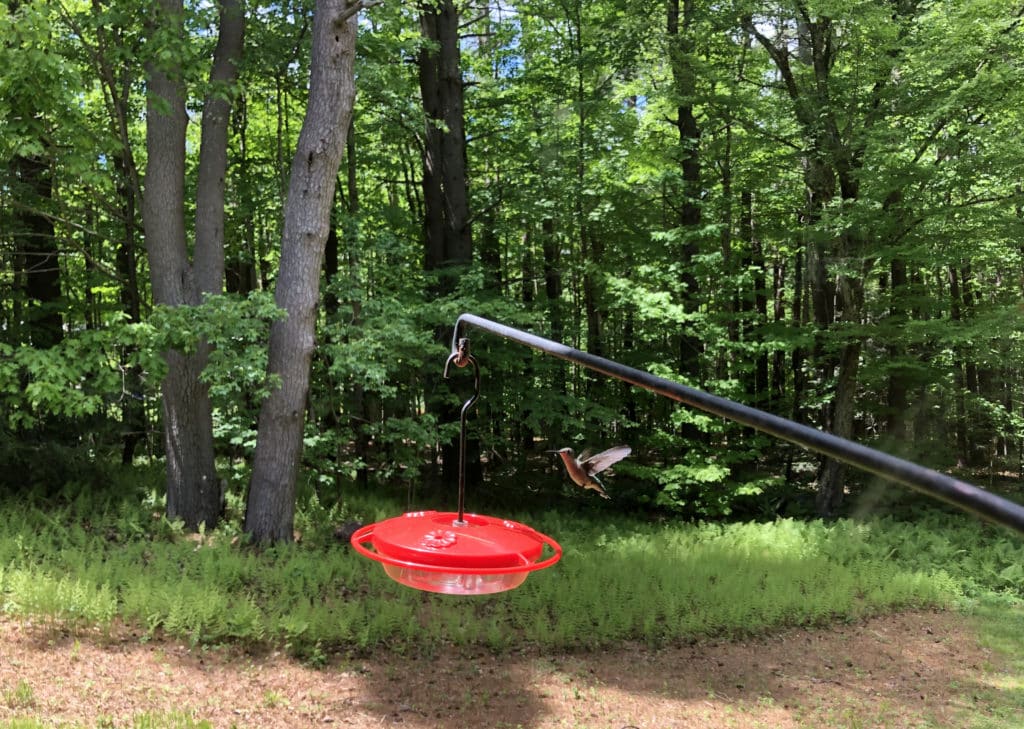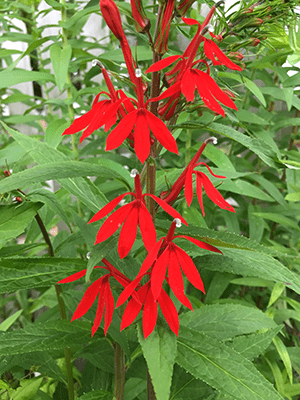
Late summer is a wonderful time for observing Ruby-throated Hummingbirds foraging in the garden, and an even better time for planning fall plantings to benefit your visiting hummingbirds next summer. There are many native plants that hummingbirds utilize for food, and providing a variety of these plants that bloom throughout the season is a great way to ensure hummingbirds frequent your garden.
Generally, Ruby-throated Hummingbirds prefer long, tubular flowers that match their long beaks and tongues, thereby making it easier for them to access the nectar within the flower (though they will also “rob” nectar through the side of flowers with different structures). They do show some preference for red, orange, and pink flowers (this is the reason for red hummingbird feeders), but any flower with abundant nectar is likely to attract them.
In May, Wild Columbine (Aquilegia canadensis) and two native beardtongue species (Penstemon digitalis and P. hirsutus) are blooming to welcome the first returning hummingbirds. During this time, they will also visit many flowering shrubs, like the dogwoods and serviceberries, as well as phlox and irises, of which there are numerous native options. Nesting sites become critical at this time: oaks, birches, and poplars are all favored by hummingbirds for nest-building. Especially when nesting, hummingbirds eat large amounts of small insects, so a diverse habitat of native plants that supports many different species of insects is most helpful to feed their young.

As summer goes on, hummingbirds take advantage of the abundant blooms. They frequent a number of native honeysuckles from June into July, including five that are native to Maine: Northern Bush Honeysuckle (Diervilla lonicera), American Honeysuckle (Lonicera canadensis), Wild Honeysuckle (L. dioica), Swamp Honeysuckle (L. oblongifolia), and Mountain Honeysuckle (L. villosa). Wild Honeysuckle and Swamp Honeysuckle are listed in Maine as endangered and special concern, respectively. At the beginning of July, Wild Bergamot (Monarda fistulosa) begins to bloom, and is one of their favored forage plants. Later in the season, two native plants stand out as hummingbird forage: Orange Jewelweed (Impatiens capensis) and Cardinal Flower (Lobelia cardinalis). Both prefer moist, shady areas, and are important food sources as hummingbirds prepare themselves for their migratory flight to wintering grounds in south Florida, southern Mexico, and Central America.
Cardinal Flower, Wild Columbine, Great Blue Lobelia, Hairy Beardtongue, and Obedient Plant are all hummingbird nectar plants that are currently still available in Maine Audubon’s Native Plants Sale.
If you already have any of these plants in your yard, now is also a perfect time to plan to collect and plant seeds from most of the species mentioned above. They all have slightly different ripening times, but Bush Honeysuckle, Wild Bergamot, Jewelweed, and Cardinal Flower all ripen and release seed between September and October. They are best sown directly on soil or mulch where you would like them to establish, or outside in pots, flats, or seedbeds, where they can undergo ‘cold-stratification’ during winter temperatures to break their seeds’ dormancy and germinate properly.
More questions? Check out this blog post: Answers to your fall hummingbird questions
